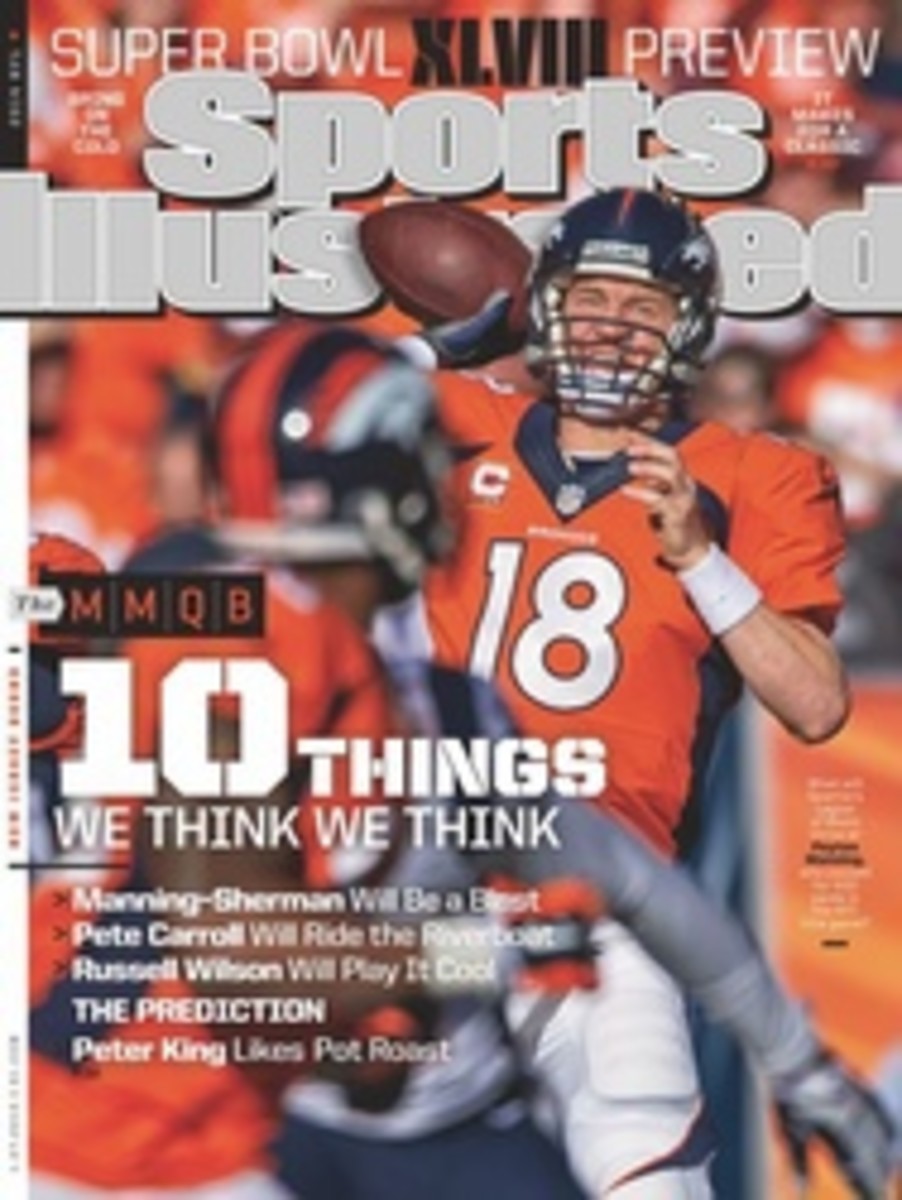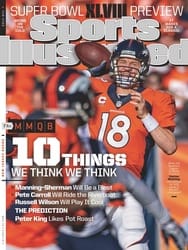
MADE IN DETROIT (AND GREAT ON ICE)
CHARLIE WHITE tested his Olympic footwork as he walked a busy hallway at the Arctic Edge ice arena in Canton, Mich., one morning last summer. He deftly dodged a stroller, a stuffed toy monkey, a warmup bag and a Tigers cap. "Kind of confusing around here," he said jokingly as a young skater scampered past him searching for a lost jacket. "Seems like the place to be."
He's got that right. White, 26, and his ice dancing partner, Meryl Davis, 27, are the reigning world champions and Olympic silver medalists—and America's best hope for a gold medal in figure skating at the Sochi Games. They are preparing for the Olympics in their sport's unlikely new mecca: greater Detroit, a city whose rise to skating prominence is an aptly Russian-accented story. The battle for ice dancing gold in Sochi will be a Motown showdown pitting Davis and White against their Canadian rivals, Tessa Virtue and Scott Moir, the 2010 Olympic champions and '13 world silver medalists, who also train at Arctic Edge and share a Russian-born coach with Davis and White.
Detroit's skating production line has been humming. In 2011 ice dancers from the Arctic Edge club swept the medals at the world championships, as U.S. siblings Maia and Alex Shibutani won bronze behind Davis and White and Virtue and Moir. Seven of the world's top eight dance teams train within 30 miles of Detroit at either Arctic Edge, the Skating Club of Novi or the Detroit Skating Club in Bloomfield Hills. The last of those is also the training home of four-time reigning U.S. men's figure skating champion Jeremy Abbott and the men's gold medal favorite in Sochi, three-time world champion Patrick Chan of Canada.
Though Detroit's ascent has attracted top skaters from around the globe, Davis and White are homegrown talents. When White was an enthusiastic but unpolished eight-year-old singles skater, from Bloomfield Hills, his then coach, Seth Chafetz, suggested he team up with a shy nine-year-old from 10 minutes up the road in West Bloomfield to help him with his balance. It was ick at first sight. White couldn't bring himself to take the girl's hand. Davis was so resistant to looking into White's eyes that Chafetz put smiley-face stickers on White's forehead in practice so she would have something else to focus on. To make the pair more comfortable with each other, Chafetz devised word games and tests of physical precision to bring out their competitive side.
The cooties wore off—quickly, and the pair became close friends. White was especially sensitive to Davis's issues with dyslexia and depth perception, and it became second nature for him to shield her from other skaters speeding by during warmup sessions. The two grew so at ease together that a year later, when they were trying on new costumes before their parents, White casually disrobed to his birthday suit in front of everyone.
The pair has long had a natural chemistry on the ice. "Why do opposites attract?" asks Marina Zoueva, who has been their coach either full- or part-time since 2001. "Charlie was a boy with the fastest feet and too much energy, and Meryl was already close to a young lady: light and elegant. But when they grew, they had a feel for music and each other."
Davis and White are engaging and down to earth, not given to the entourages and air kisses that sometimes characterize their sport. Asked if they ever fight, White puts up two fists and grits his teeth. Davis just laughs at him. "We're really not very good at it," she says. "Getting along is easier."
Their congeniality can extend even to their closest competitors. Davis and White and Virtue and Moir avoid incorporating moves performed by the other, out of what Moir calls "respect for boundaries." They look after each other's skates and equipment at practices and competitions, a rarity in the sport.
All four have known each other for close to a decade, and White and Moir go back further, to their days as eight-year-olds playing youth hockey on opposite sides of the U.S.--Ontario border. Once, when their teams met, a brawl broke out among players. White ducked off to the side. Moir jumped onto the pile. Police later arrived to break up fights between parents in the hallway.
Not to say that White isn't an equally tough competitor, but Moir, who played the sport until age 15, still has a bit more of the hockey mind-set. That became clear after Virtue underwent surgery on her shins in 2008. While his partner recuperated, Moir trained solo for several months by attaching a sandbag to a hockey stick and dancing around with it.
THE EVENT that spawned Michigan's ice dancing boom occurred in 1990. British greats Jayne Torvill and Christopher Dean, the 1984 Olympic gold medalists, were headlining a tour of international skaters that made a stop in New York City. Three Russian members of the troupe were planning to defect. They asked countryman Igor Shpilband, a former world junior champion in ice dancing, to help them carry their bags to the train station a day before the team's scheduled return flight to Moscow. Shpilband obliged.
Shpilband had no plans to stay in the U.S. until he realized that the KGB would quickly figure out that he had helped the others. He was soon sharing a one-bedroom apartment with the other skaters in Brooklyn's Russian enclave of Brighton Beach, sleeping on a mattress he found in a Dumpster. "I didn't think I'd find work as a skating coach," he said, "much less build an [empire]."
Shpilband got a break when, three weeks after he defected, the Detroit Skating Club offered to bring in the group as skaters or coaches. The club had been started in 1949 and had produced Tim Wood, the world champion in 1969 (and much later Tara Lipinski, the Olympic champ in 1998). Shpilband arrived on an unseasonably warm February day and recalls thinking, "Wow, Detroit is so warm in February. Where are the palm trees?" A blizzard hit several days later and brought him back to reality.
Shpilband went to work nurturing ice dancing champions at junior and senior levels, including Elizabeth Punsalan and Jerod Swallow, who won four of their five U.S. titles in the 1990s under Shpilband. Now Swallow operates the club. Teams coached at least in part by Shpilband won every U.S. ice dancing championship from '96 through 2012. In '01 he joined coaching forces with Zoueva, a Russian dance coach and choreographer who had emigrated a decade earlier.
Both coaches moved to nearby Canton a year later to start their own program. In 2012, Shpilband was dismissed after a complicated power struggle with Zoueva. He now coaches Madison Chock and Evan Bates, the No. 2--ranked U.S. dance team, at the club in Novi, 20 miles north.
The skaters who have come to train under him or Zoueva have found the Detroit area unexpectedly inspiring. "Escapism is part of skating," says Virtue, a regular at the city's Fox Theatre downtown. "I love imagining Detroit in its heyday. When you come into the city and see the steam coming off the manhole covers, it's almost hauntingly beautiful. It lends itself to the skating mind-set." A car enthusiast, Chan, who has trained in Michigan under coach Kathy Johnson since last February, frequently attends local auto and racing shows. "It's the perfect place to get fired up," he says.
When Zoueva speaks of a "new model" for today's elite ice dancers, she describes a hybrid of Russian refinement and North American working-class dedication. (Davis's mother, Cheryl, is a retired special-education teacher, and her father, Paul, works in the real estate industry. White's parents, Jacqui and Charles Sr., run a home-heating-oil distributor in Detroit, for which Charlie's brother Jason drives a delivery truck.) "It's like a pretty package that is tough and unbreakable," Zoueva says. "It can be classical or modern, precise or energetic. The best today draw from so many influences. The difference from 20 or 30 years ago is dramatic."
REMOVE TORVILL and Dean from the scene, and the world champions in ice dancing came from the old Soviet Union or its republics in 24 of 26 years between 1970 and 1999. But since the Vancouver Olympics, the two North American teams have traded gold titles at the world championships (Virtue and Moir in 2010 and '12; Davis and White in '11 and '13) with the other couple taking second each time.
"They really transport you," says skating analyst and Olympic gold medalist Scott Hamilton of Davis and White. "Their programs have a lot of integrity, a lot of range. They're amazing."
In Sochi they will skate a playful original dance set to "My Fair Lady," using fox-trot and quickstep patterns to skip across the ice. The free dance, sure to be a hit with anyone schooled in classical drama, is set to "Scheherazade," by Russian composer Nikolai Rimsky-Korsakov. It's the story of the queen who saved her life by telling spellbinding cliffhanger stories for 1,001 nights to her husband, the Persian king Shahryar, who had previously beheaded his wives after a single night of marriage. "I like it so much," says Davis, "because she was using her art to fight for her life every day." Davis and White will be favored in Sochi both for their technical precision and for the dynamic entrances to their lifts.
Though not a couple, Virtue and Moir are more sultry, playing on a romantic tension between the two that is scripted but convincing, as if their programs should be set to low lights. When Virtue returned from her 2008 surgery, the two skaters even consulted a marriage counselor to regain compatibility.
"Having such beautiful couples will not happen again for many generations," says Shpilband. "When they stop competing soon, we will really lose something special."
That will happen after this season. Virtue hopes to attend law school after finishing her degree at the University of Windsor, and Moir says he will work on a farm and watch hockey. Davis and White, both juniors, will resume their studies at Michigan—White is focusing on political science while Davis is studying anthropology—on what White jokingly calls the 10-year plan.
"After the last skate in Sochi, maybe I close my eyes to stop the time," says Zoueva. "Charlie and Meryl have been a dream, always doing what is asked. When Tessa has an idea, we've played around with it to make the program. It's like your children. You love them both, but you talk to them differently. Before them I didn't realize why I love skating. Today I want to breathe this air in Michigan to feel how dance can change your soul."
Follow @BrianCaz
OLYMPIC PREVIEW
Meet 18-year-old skier Mikaela Shiffrin and the rest of Team USA—and learn who will medal in every event—next week in SI's guide to the Sochi Games.
PHOTO
Photograph by AL TIELEMANS/SPORTS ILLUSTRATED
PERFECT PAIRING The elegant Davis and the athletic White come together to create stunning lines that few competitors can match.
PHOTO
SERGEI ILNITSKY/EPA/LANDOV
RUSSIAN INFLUENCE Coaches Zoueva and Shpilband have honed the skills of Virtue and Moir (far left and below), Davis and White and the Shibutani siblings.
PHOTO
FRANCOIS MORI/AP
[See caption above]
PHOTO
AL TIELEMANS/SPORTS ILLUSTRATED
SINGLES PURPOSE Chan (near left), who is the favorite to win the men's gold medal, trains near Detroit, as does Abbott, the U.S. champion.
PHOTO
GONZALO FUENTES/REUTERS
[See caption above]
PHOTO

